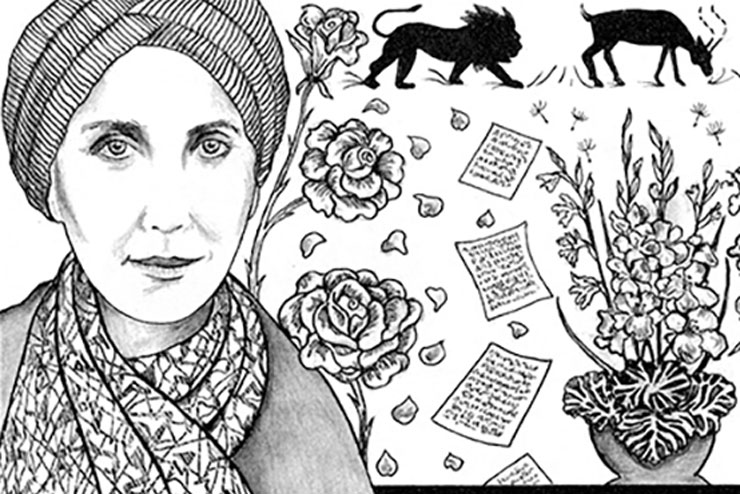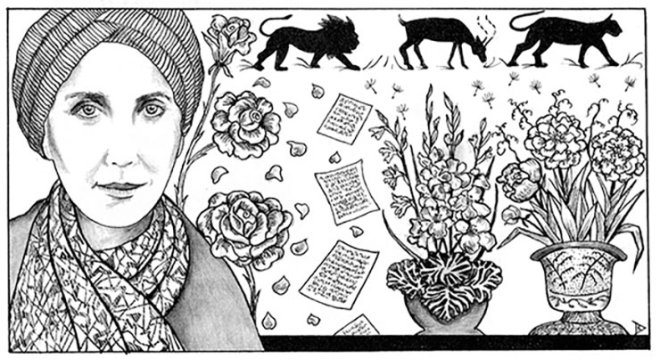
Do you find connection and regeneration in gardens? Do you speak the language of flowers? Of course you do, because I think, like me, gardening is a source of nourishment for you. As a part of that, you probably love to experience other people’s gardens.
One I love in particular is nearby to me. My wife and I have worked from a creekside home office outside of Asheville, North Carolina for many years, which is home to not only the largest home in America, the Biltmore, but also 75 acres of formal and informal gardens on their 8,000-acre estate. The formal garden is so large that many people walk half of it and then take a car to the end of it to do the other half. But walking through it is mesmerizing, the sights, colors, smells, and the tiny creatures that make the garden their home are all so rejuvenating to one’s spirit.
In today’s piece from Anne McGouran, Planted by the Mind, she explores the connection between gardening and creativity, but specifically how gardens can impact writing when you speak in the language of flowers and other plants. If you have a love for gardening history, writing, or just know how it feels to be transformed within the walls of a garden for the better, then I think you’ll enjoy today’s story.
Discover 7 top tips for growing, harvesting, and enjoying tomatoes from your home garden—when you access the FREE guide The Best Way to Grow Tomatoes, right now!
See, Smell, and Experience a Garden in the Language of Flowers
This story comes from our archive that spans over 30 years and includes more than 130 magazine issues of GreenPrints. Pieces like these that inject gardening history into fun stories always brighten up my day, and I hope it does for you as well. Enjoy!

Planted by the Mind
Exploring the connection between gardening and writing.
By Anne McGouran
“Roses and nightingales are flourishing. Even the strawberries are beginning to ripen. And what roses! The house, the walls, the gardens are all covered . . . I have never seen so many, nor such varieties. It’s a horticultural explosion of roses. The more one cuts, the more they bloom.”
– Colette
“The air was cold to the lungs, the long grass dripping wet, and the herbs on it gave out their spiced astringent scent. In a little while on all sides the Cicada would begin to sing. The grass was me . . .”
– Karen Blixen (Isak Dinesen)
In my student days, I lived in a sixth-floor studio apartment overshadowed by a high-rise office. My small container garden flourished or withered depending on two things: (a) the sun’s movement above the Minto condominium’s north tower and (b) whether my creative writing had gone well that week. A secret scribbler of short stories, I spent every spare moment jotting character sketches and overheard bits of dialogue in my Book of Kells-cover writing journal. Often, I despaired of fully capturing what was in my mind.
Early one spring, my French marigolds and pansies experienced a growth spurt. Seated on my outdoor writing stool, I inhaled the spicy insecticidal smell, contemplated those soft lavender petals, and took up my pen. For one heady hour, words lifted off the page. The resulting short story was published in the university newspaper’s arts and culture section.
I sensed a connection.
The following year, I came upon two kindred spirits in the library stacks: women writer/ gardeners who also discovered the mystical connection between gardening and writing. more than one century ago. For Karen Blixen and Colette, gardening offered a place in the mind where the boundaries between the cultivated and the wild were blurred. Chafing at the social codes of their time, both women discovered the recuperative pleasures of gardening while finding their voice as writers.

The Danish author Karen Blixen (1885-1962 1962) first became a writer when she lived in Kenya, but did most of her writing (including Out of Africa, her most famous book) after she moved back to Denmark. There, the parklands and gardens of her ancestral Rungstedlund (a former inn surrounded by native flowers and fruit trees) sparked her creativity. She planted a now-famous rose garden that was sheltered by the main cottage’s south wall.
She planted white lilies and cinerarias “twenty times in different types of soil.” At her request, her lover sent daffodils and crocus bulbs to plant as well.
Blixen maintained a formal garden by the main cottage and a more private cutting garden, which supplied flowers for fresh bouquets. Described as an amateur florist because of the bold arrangements she placed in every room of her house, Blixen devised astonishing mixes of flowers (roses, tulips), vegetables (red cabbage), even weeds (cow parsley, gone-to-seed dandelions). Peonies with leeks and cabbage leaves with gladioli were just two of her innovative combinations.
Karen Blixen’s short stories reflect a lifelong search for the ecstatic. In her writing she often mused about the aesthetic unity in the world. (“If I looked in the right place, I reflected, the coherence of things might become clear to me.”) She also had an appreciation for the wildness of nature. At Rungstedlund, she allowed the vegetation to grow and decompose naturally to avoid disturbing the local wildlife.

Nicknamed “the eternal apprentice” Colette (1873-1954; Gigi and Chéri are two famous works) continually reinvented herself—she even learned to ride a bicycle at age 50. The daughter of a passionate gardener, Colette is at her captivating best when she writes about gardens. Reminiscing about her mother’s house in Basse-Bourgogne, she says that it “only smiled on its garden side. The back, invisible to passers-by, was swathed in a mantle of wisteria” and contained “begonia too heavy for the trellis of worn ironwork which sagged in the middle like a hammock.”
Colette preferred honest” unpretentious gardens and disparaged hybrid plants. Her essay collection Flowers and Fruit contains lyrical botanical portraits of 38 species including Persian violets, campanula, peonies, lilies, and lily of the valley, She tells us that “The true lily’s favorite soil is the kitchen garden’s with tarragon, sorrel edgings and purple garlic for neighbors.”
What impulse led her from the writing room to the garden? In the middle of a life overflowing with children, husbands, lovers, protégés, and literary agents, Colette needed a calm space. And so she planted roses and tangerine trees at her summer house in Saint Tropez and reveled in the flowers and trees at her Brittany retreat in a valley sloping down to the sea. She speaks glowingly of her “friendship with the hammer and the nail, the rake and the dibble.”
When Colette moved to rooms in Paris’s Hotel Claridge, she grew geraniums and strawberries in pots on the balcony, commenting lightly that “the fauna of Paris hotels is still little known.” The writing desk in her “petite chambre rouge” always held vases of fresh flowers.
Both Blixen and Colette were determined to (as Blixen put it) “maintain their own center of gravity.” Their literary sensibilities flourished in garden sanctuaries; their personalities shone through in their love of unconventional flowers. They often referred to the healing power of plants and the joy of physical labor. They knew that whatever goodness we put into the ground comes back to us.
Karen Blixen stewarded her magical parklike garden so that the public could enjoy it after her death. The public repaid her by naming a fragrant rose the Karen Blixen Hybrid Tea Rose, a pure white beauty that blooms from summer to autumn. At the end of her life, Colette was gorging on soft-boiled egg with fresh-picked cherries and leaning on her Paris windowsill observing the flower beds of the Palais Royale. One more garden to reimagine.
Like Blixen and Colette, I too, find connection and regeneration in gardens. I find it in their writings, as well. Indeed, I also hope to create and visit as many garden sanctuaries as possible and then distill all that wild beauty into words. ❖
By Anne McGouran, published originally in 2017, in GreenPrints Issue #110. Illustrations by Blanche Derby.

Did you enjoy this history lesson? Do you feel like you speak in the language of flowers and other plants, or at least understand it? I feel like I do!
Discover 7 top tips for growing, harvesting, and enjoying tomatoes from your home garden—when you access the FREE guide The Best Way to Grow Tomatoes, right now!




